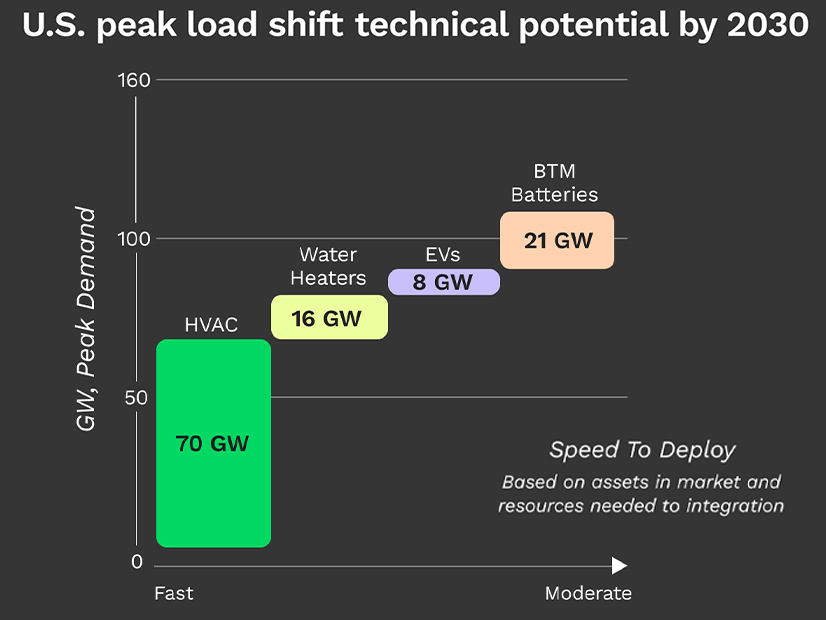Home energy management company Renew Home released a position paper last week arguing that the virtual power plants it creates with aggregations of residential customers can quickly be stood up to help meet growing demand.
As the generation mix shifts ever more toward intermittent renewable resources, the grid needs to be balanced at specific times, which VPPs can help with, Renew Home Executive Vice President Cisco DeVries said in an interview.
“We need to find hundreds of gigawatts of additional capacity in order to meet the challenges faced by the growth in demand for electricity and the management of more intermittent renewables,” DeVries said.
VPPs are going to be key to meeting that demand because they can be stood up around the country much more cost effectively and quickly than other options, including building new natural gas plants, he argued.
“A lot of entities are taking an all-of-the-above approach: looking at natural gas, looking at batteries and looking at VPPs,” DeVries said. “And fundamentally, from an economic perspective, it’s really hard to get there with gas alone, right? Even if you set aside the climate and greenhouse gas impacts, which are significant, you still have an issue of building hundreds of gigawatts of new generation capacity, much of which is only needed for small portions of time in the year.”
Renew Home is a member of Sidewalk Infrastructure Partners, which was formed as an independent entity out of Alphabet, Google’s parent company. The company was created earlier this year by the merger of Google’s Nest Renew service and OhmConnect, and is the largest residential VPP provider in the country, with almost 3 GW under control and plans to expand up to 50 GW by 2030.
Core to that expansion will be growing the number of smart thermostats to cover more of the 82 million homes that have central HVAC systems. Pairing every single HVAC system with a smart thermostat and linking them to a VPP could create 70 GW of load-shifting potential, the company argues in the paper.
Smart thermostats are the quickest way to set up residential VPPs, it says, but electric vehicles and distributed batteries are also part of the plants. The paper forecasts 8 GW worth of EVs and 21 GW of batteries charging by 2030.
VPPs come out of traditional demand response and can still provide that emergency service to the grid when needed, DeVries said, but they are meant to operate more often with less of an impact on the individual customers in an aggregation. They are “designed to run 3 to 5% of the time [and to] have predictable, reliable dispatch in a way that can be just as good as, if not better than, fossil fuel plants.”
They can also do the same work as peaker plants, but even more cheaply without factoring any of the environmental externalities of their competitors, he said.
While most customers are not interested in being a resource that has to respond to changing grid conditions, spreading VPPs out among many customers with smart thermostats can get around and aggregate capacity without too much aggravation.
“We have millions of customers using Nest thermostats who have already given permission to flex their load,” DeVries said. “To say, ‘go ahead, make some modest adjustments in the temperature; pre-cool a little here; let it drift a little there; whatever you want to do. I’m comfortable with it.’”
Renew Home manages their thermostats every day to help customers manage time-of-use rates, save money on their bills and even to use power when the carbon intensity of the grid is lower.
“We have got not only an enormous stranded asset now, as far as gigawatts of existing load that is ready to be controlled today, but there is a near-term pathway to get that into the 50 to 70 GW over the coming few years, and that could transform the reliability of the U.S. grid and also help people actually reduce their energy bills pretty dramatically,” DeVries said.
Electric water heaters could provide another 16 GW in load shifting if connected to smart controllers.
“There are millions and millions of hot water heaters that are put into people’s homes every year, and with a small additional effort, those are all controllable and can be navigated in the same way we do thermostats,” DeVries said. “Customers won’t even notice it’s happening, but their hot water heater will participate, essentially as a thermal battery shifting load around. The capabilities of that are dramatic.”




